Archive for the ‘Canada’ Tag
Vancouver’s bold war on drugs
 For many years Vancouver has had a serious heroin addiction. So it’s heartening to see that one of the city’s boldest strategies for confronting the problem, launched eight years ago, is continuing to meet with serious success: Vancouver’s government-backed “supervised injection site” — the first of its kind in North America — has helped reduce the number of fatal drug overdoses in the city by 35 percent, according to a new scientific report detailed in the Vancouver Sun.
For many years Vancouver has had a serious heroin addiction. So it’s heartening to see that one of the city’s boldest strategies for confronting the problem, launched eight years ago, is continuing to meet with serious success: Vancouver’s government-backed “supervised injection site” — the first of its kind in North America — has helped reduce the number of fatal drug overdoses in the city by 35 percent, according to a new scientific report detailed in the Vancouver Sun.
The news is gratifying for me personally, having invested deeply in the issue with a reporting project I did for Salon beginning in 2003. (My initial story from Vancouver’s notorious Downtown Eastside — a neighborhood much changed these days, particularly since the 2010 Winter Games — is linked above.) Reporting another piece in 2006, one of the most striking things I found was that early results from Insite, as it’s called, had already converted some hardcore conservatives. Then city councilor George Chow — who had campaigned vigorously against the injection site when running for office — told me in fall 2006 that conservatives’ ideological fears had been misguided. They had declared that a government-sponsored facility for helping drug users shoot up would only breed more chaos.
“After three years that has not happened, even with an increase in the homeless,” Chow told me then. “Without this facility the drug problem would have been far more out of control. There would be an even bigger problem with HIV transmission and other issues.”
As I wrote at the time, research showed that Insite had also helped sharply reduce the sharing of dirty needles among street addicts and increased their entry into detox and addiction treatment programs. Supporters of Insite believed that the facility’s success would prove a beachhead for a less punitive and more humane war on drugs extending across Canada, and perhaps even to drug-troubled cities south of the Canadian border. Chow himself suggested that Toronto and Montreal, as well as U.S. cities with similar problems, should consider the policy already working so effectively in his own neighborhood.
Now, he and Insite’s other supporters can point not only to a reduction in fatal overdoses but also to a rigorous research report making that same recommendation. The report was published Sunday, as the Vancouver Sun noted, in the prestigious medical journal The Lancet:
The report, compiled by Canadian scientists from the Urban Health Research Initiative, the B.C. Centre for Excellence in HIV/AIDS and St. Paul’s Hospital, goes on to argue that Vancouver’s Insite — the country’s first safe-injection facility — should be replicated in other North American cities where drug use is a common problem. …
In a column accompanying the report, Dr. Chris Beyrer, Johns Hopkins Bloomberg School of Public Health, commended the facility’s work in helping drug abusers. “Supervised injection facilities clearly have an important part to play in communities affected by drug use. They should be expanded to other affected sites in Canada, on the basis of the life-saving effects identified in Vancouver,” he wrote.
Maybe city leaders in Baltimore, San Francisco and New York City will finally take notice, too. For a deeper dive into Vancouver’s acute hard-drug crisis, and Insite’s role in helping contend with it, read this piece.
Postcard from Vancouver
A few snapshots from the final weekend here at the 2010 Winter Games.
The Olympic Cauldron at the convention center in downtown Vancouver, early Saturday evening:
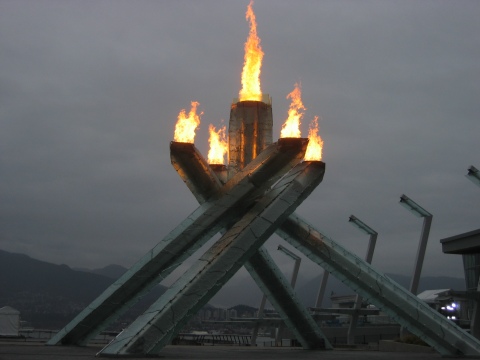
The Olympic Rings on a barge just off Stanley Park in Coal Harbour, early Saturday evening. Every time Canada won a medal, the Rings changed color for a little while accordingly, to gold, silver or bronze.
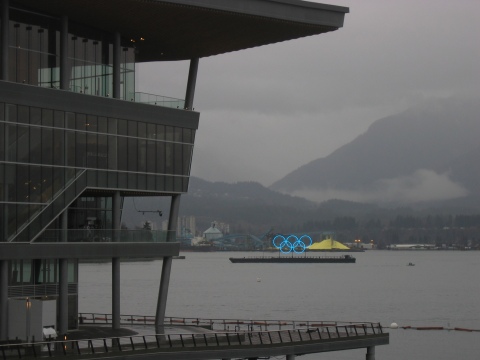
 By mid morning on Sunday, every single drinking establishment in the downtown area had a line around the block in anticipation of Canada facing off against the United States in the hockey gold medal finale. Some people were offering $100 just for a guaranteed spot to watch the game… in a bar. On Saturday night, some tickets to the game for sale online apparently were going for as much as $10,000.
By mid morning on Sunday, every single drinking establishment in the downtown area had a line around the block in anticipation of Canada facing off against the United States in the hockey gold medal finale. Some people were offering $100 just for a guaranteed spot to watch the game… in a bar. On Saturday night, some tickets to the game for sale online apparently were going for as much as $10,000.
A building at Georgia and Burrard streets draped in the Canadian flag:
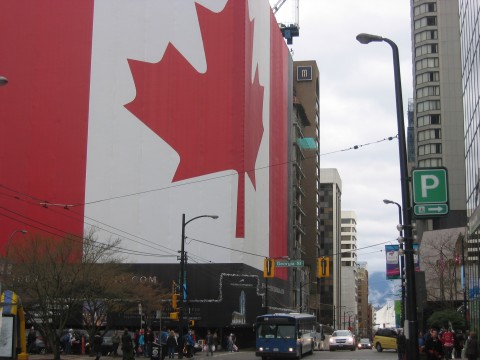
Vancouver is an international city on a normal day, but for the past couple of weeks has transformed into a truly global village, with legions here from all over the world. It’s been fun just to walk the streets and mingle with the excited and friendly (and youthful) masses:
Bonus question: Is it really true that Russian skater Victor Plushenko was once an American rock star?
The spirit of Haida Gwaii
In late August I returned to the archipelago of Haida Gwaii, a place whose ancient, complex culture and astonishing natural beauty are inextricable. Earlier this week, in the village of Old Massett, the renowned Haida artist Robert Davidson hosted an epic two-day celebration commemorating the totem pole he carved here 40 years ago. The pole was raised in the village on August 22, 1969, replanting a vital Haida tradition that had nearly disappeared by the end of the 19th century. It was a privilege and joy to attend the festivities and to participate in documenting them. Here are a few images I captured (please do not reproduce them without permission), though they only begin to suggest the layers of landscape, art and ceremony that were on display.
The many performers included singers, drummers and dancers from Skidegate:

Spruce-root woven and painted hats filled the community hall:

The Tsimshian group Git-hoan, or People of the Salmon, were among the guests invited to perform:

Eagle Transformation Mask, carved by Robert Davidson and danced publicly for the first time by the Rainbow Creek Dancers:
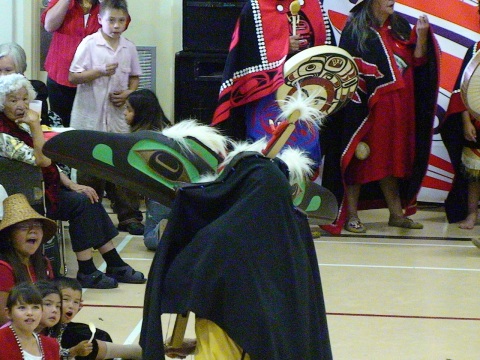

Robert Davidson’s 40-foot Bear Mother pole (partial view), raised in Old Massett in August 1969:
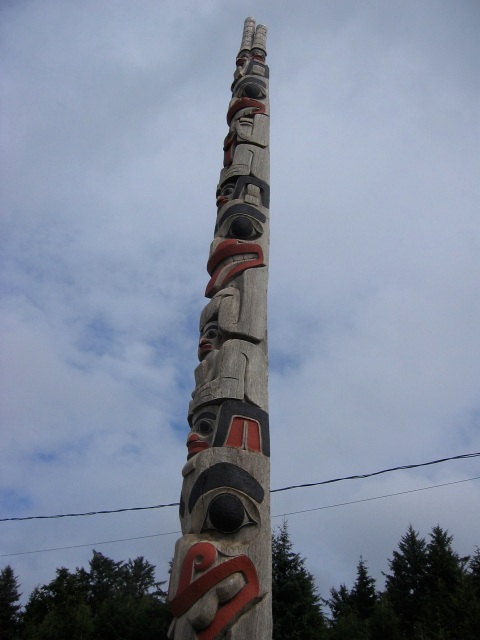
Despite devastation from decades of industrial logging, some majestic old trees still stand on Haida Gwaii. (Thanks to the tireless efforts of local advocates and defenders, the land increasingly has come under protection in recent years.) The temperate rain forests are home to towering cedar, hemlock and spruce:
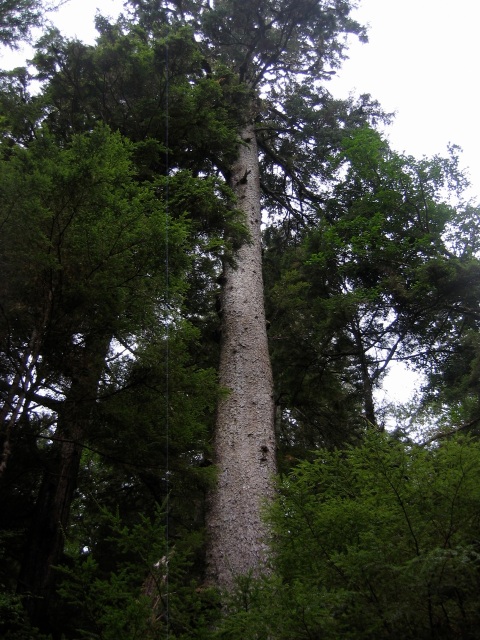
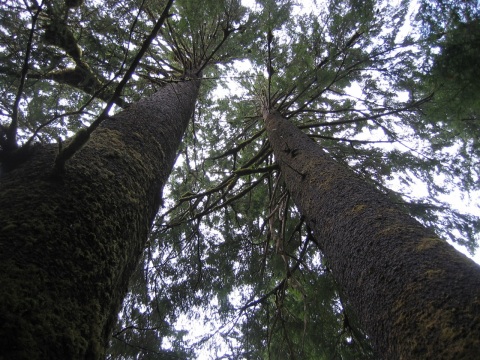
Along the banks of the Yakoun River, near where K’iid K’iyaas, the legendary Golden Spruce stood until its untimely demise in 1997. Every year the salmon come back to this essential river artery of Haida Gwaii. At least for now.

A Supposedly Fun Thing That Seems to Kill Whales
I took notice back when David Foster Wallace chronicled the cultural dark side of going on a cruise. But ultimately it’s the environmental dark side of the industry that makes me know I’ll Never Do It at All.
Over the weekend, an adult fin whale — a threatened species in Canada — turned up dead in the waters at a cruise ship terminal in Vancouver. The rare marine giant was impaled on the bow of the “Sapphire Princess,” a Princess Cruises’ ship arriving from Alaska:
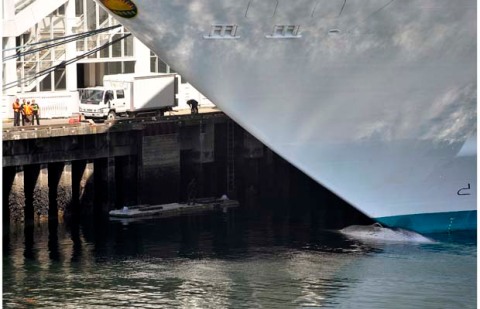
(Jenelle Schneider/Vancouver Sun)
Tragic, gruesome and strange — the size of the ship really begins to sink in when you realize that the dead fin whale pictured above is approximately 70 feet long, a magnificent giant cruelly rendered small. (More photos here in the Vancouver Sun’s report, and more here on Flickr.) Consider, also, that soon the 2,670-passenger Sapphire Princess won’t even nearly measure up to the largest, most consumptive recreational beast riding the seas. That’ll be the stupefying Oasis of the Seas.
According to the Vancouver Sun, the Department of Fisheries and Oceans will conduct a necropsy to determine if the ship struck the fin whale while it was alive or if the whale had already been floating dead at sea and got caught on the bow. The latter seems the less likely scenario. A fisheries spokesperson, Lisa Spaven, appeared to acknowledge as much: “Vessel strikes are a very real threat to fin whales,” she told the Sun.
Moreover, an account I heard today from a source in Vancouver appears to contradict a statement put out by Princess Cruises this weekend regarding whales in the vicinity of the ship.
“It is unknown how or when this could have happened, as we have strict whale avoidance procedures in place when our ships are in the vicinity of marine life,” the statement from the cruise company said. “We are not aware that any whales were sighted as the ship sailed through the Inside Passage to Vancouver yesterday.”
But according to my source, two passengers who arrived on the Sapphire Princess in Vancouver this weekend said that several passengers on the ship had seen whales swimming around and under the ship as it traveled the Inside Passage cruise route just north of Vancouver Island.
Spaven, the DFO spokesperson, told the Vancouver Sun that she believes the whale was struck north of Vancouver Island, since fin whales aren’t normally found in the straits closer to Vancouver.
The Inside Passage is famously rich with marine wildlife and is a crucial habitat and migratory route for whales. As the Sun also reports: “This is the second time in the last 10 years that a cruise vessel has come into the Port of Vancouver with a whale caught on the bow. In that instance, in June of 1999, the Celebrity Cruise vessel MV Galaxy collided with an adult male fin whale, which likely happened as the ship transited the Hecate Strait north of Vancouver Island.”
For some compelling related reading, I strongly recommend Charles Siebert’s article “Watching Whales Watching Us,” published recently in the New York Times Magazine. It’s a deep, enthralling account that dives into some provocative thinking among marine biologists today about our evolving relationship with whales — which may yet hold hope, despite our terrible history of assault on one of the earth’s most sublime creatures.
PART 2:
There is more to Princess Cruises’ history with whales. In the summer of 2001, one of its ships slammed into a pregnant female humpback whale in the waters off Southeast Alaska, killing it. As Mother Jones reported two years ago via a National Park Service report, in January 2007 “Princess Cruise Lines pled guilty in U.S. District Court in Anchorage to a charge of knowingly failing to operate its vessel, the Dawn Princess, at a slow, safe speed in the summer of 2001 while near two humpback whales in the area of Glacier Bay National Park. The bloated carcass of a pregnant whale was found four days after the Princess ship sailed through the park. It had died of massive blunt trauma injuries to the right side of the head, including a fractured skull, eye socket and cervical vertebrae, all consistent with a vessel collision.”
You can read the rest of the report at the MoJo link above, including details of the six-figure penalty paid by Princess in a plea agreement. At the time of the agreement, the U.S. attorney’s office stated, “in this case we feel Princess has stepped up and made significant, voluntary operational changes that protect whales and the marine environment.”
Pending findings on the Sapphire Princess and the fin whale’s death, perhaps that assessment needs updating.
I’m compelled to add that I feel a particularly personal sense of investment in this story. Exactly a decade ago, I was fortunate to have an opportunity to travel into Glacier Bay, along with three good friends, on a 10-day sea kayaking trip. I’ve explored deep wilderness throughout my life, and Glacier Bay was among the most memorable places I’ve ever been. On a couple of days during the trip, we spotted cruise ships on the horizon. We were thankful to be far away from them. In this photo I took from my sea kayak in July 1999, you can see a large cruise ship in the distance (at the right-center edge of the image) heading north against the backdrop of the Fairweather Range.
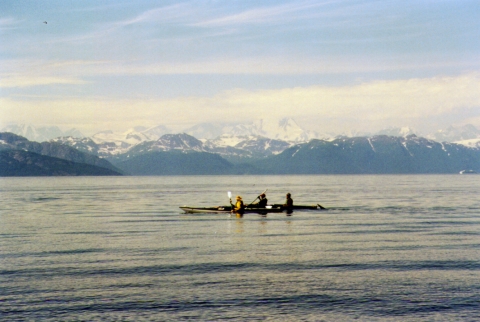
We camped on nearby shoreline that night, where an exquisite sunset perhaps hinted at what was to come on day nine of our trip.
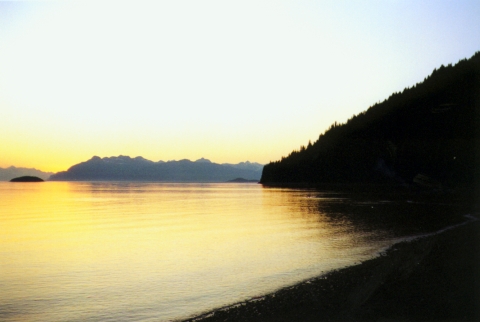
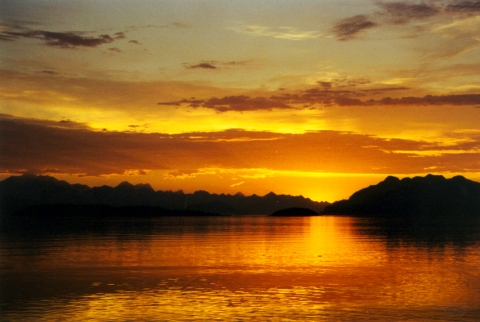
The next morning we paddled into the placid waters of Beartrack Cove to the east. We were sole representatives of humanity in a place that sees little of it. There were colorful marine birds, salmon returning to spawn in coastal streams… and suddenly that morning, one enormous humpback whale. It surfaced about 30 yards in front of our tiny, tiny boats.
The whale appeared to be feeding, its dark mass breaking the surface several times with its huge mouth open. We stopped paddling and tapped the rails of our boats gently to let it know our location. We watched in awe as it reappeared around us at various spots in the cove for about half an hour before it submerged for other waters.
It was the most glorious kind of nervous I think I’ve ever felt, a truly unforgettable experience.
The long goodnight
For a number of reasons Vancouver at this time of year is a great place to be doing some research and writing. Among them is that the sun doesn’t wink out entirely until about 10pm. This was Monday evening, overlooking English Bay.

A Titanic for these times
The June issue of the Atlantic has a look at the mind-blowing Oasis of the Seas, a gargantuan ocean liner forthcoming from cruise company Royal Caribbean International. Its unprecedented scale of apparent luxury surely required feats of engineering. But any awe that inspires would seem to wash away with apprehension of the ship’s untold economic and ecological hubris.
A decade ago, a large cruise ship typically carried in the neighborhood of 2,000 passengers and 1,000 crew members. But in an industry intently focused on swelling its profits no matter the non-fiscal costs, bigger is always better. Ordered in 2006 for $1.4 billion (on the crest ahead of the economic meltdown), the Oasis leaves those old numbers far in its wake. “In November,” writes Rory Nugent, “Royal Caribbean will take delivery of a true sea monster. Now in its final phase of construction, the Oasis of the Seas will be the biggest (longest, tallest, widest, heaviest) passenger ship ever built — and the most expensive. It will dwarf Nimitz-class aircraft carriers and cast shadows dockside atop 20-story buildings. A crew of 2,165 will tend the expectations of up to 6,296 passengers.” (Photos from the official Oasis site.)
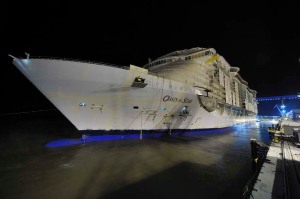
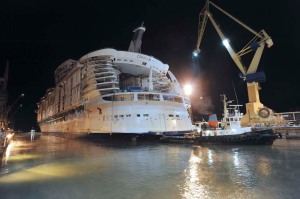
According to the Atlantic, the ship has 21 swimming pools onboard, circulating more than 600,000 gallons of water. Passengers are expected to consume another 560,000 gallons per day, including daily production of 110,230 pounds of ice cubes — more than the weight of nine adult male elephants. The Oasis will also function as “its own utility company” with a 100-megawatt electrical grid — which will consume 12 tons of diesel fuel per hour and generate enough juice to power 105,000 homes.
There is a 1,380-seat playhouse onboard, though it’s not even the main attraction. That would be the outdoor “AquaTheater,” which apparently is “wrapped in its own wind-shielded microclimate” and uses nearly 2,000 nozzles to spray water in concert with a Las Vegas-style light show.
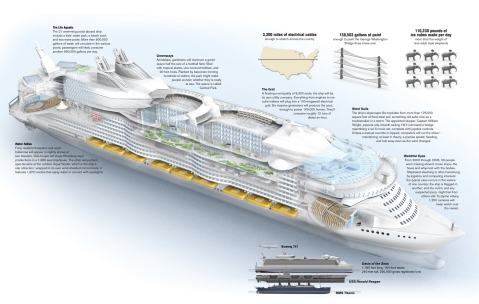
A good many people enjoy this kind of thing, the decadent vacation cruise. (Enough of them to support an industry with annual revenues in the tens of billions of dollars.) Based on the intuition that the experience might feel a bit like feasting on a nine-course meal in the middle of an Ethiopian refugee camp, I’ve never had any intention of trying it. David Foster Wallace famously once did. It’s a safe bet that the Oasis of the Seas would have left him royally retching. (His great essay “A Supposedly Fun Thing I’ll Never Do Again,” originally published in Harper’s in 1996 as “Shipping Out,” was made available online by the magazine after his tragic death last fall.)
From Florida to Alaska, the consumptive ships of Royal Caribbean have been in the news before. Seven years ago federal investigators determined that the cruise company had covered up massive environmental malfeasance, despite a case focusing on one of its ships, the Norway, that resolved with a $1 million slap on the wrist. As USA Today reported in November 2002:
Now, some of the federal agents who investigated the case say the company’s pollution went on for much longer and was much worse than the light fine suggests. Environmental Protection Agency agents say — and court records support — that the Norway not only poured hundreds of thousands of gallons of oily bilge water into the ocean. It also dumped raw sewage mixed with hazardous, even cancer-causing, chemicals from dry cleaning and photo development into the waters near Miami for many years.
In the late 1990s, according to that USA Today report, Royal Caribbean had eventually pleaded guilty to 30 criminal charges in Miami, New York, Puerto Rico, Los Angeles, the Virgin Islands and Alaska, and had paid $27 million in fines in 1998 and ’99. By the 2002 news report, it had “implemented a companywide environmental compliance program.”
About to embark with its new mega-ship (click on the first link in this post to zoom in on the above graphic), has it since cleaned up its act? A year ago this week, a Royal Caribbean cruise ship dumped 20,000 gallons of contaminated water just off the coast of Southeast Alaska.
Breaking the addiction to the drug war
In Vienna this Wednesday policy makers will convene once again to consider the United Nations strategy for battling illegal narcotics worldwide. It’s a war that is statistically impossible to win. A report today from the Guardian points to the massive cocaine trade out of Latin America to exemplify how the supply-side war on drugs is equivalent to shoveling water on an international scale:
The crucible is Colombia, the world’s main cocaine exporter. Since 2000 it has received $6 billion in mostly military aid from the US for the drug war. But despite the fumigation of 1.15m hectares of coca, the plant from which the drug is derived, production has not fallen. Across the whole of South America it has spiked 16%, thanks to increases in supply from Bolivia and Peru.
Says César Gaviria, Colombia’s former president and co-chair of the Latin American Commission on Drugs and Democracy: “Prohibitionist policies based on eradication, interdiction and criminalisation have not yielded the expected results. We are today farther than ever from the goal of eradicating drugs.”
Says Colonel René Sanabria, head of Bolivia’s anti-narcotic police force: “The strategy of the US here, in Colombia and Peru was to attack the raw material and it has not worked.”
 Halfway around the world it’s the same story with the heroin trade out of Afghanistan.
Halfway around the world it’s the same story with the heroin trade out of Afghanistan.
Respected U.S. economists and judges agree: Our long-running drug policy with ideological roots tracing to Reagan and Nixon has gotten us nowhere.
If, as Tom Friedman argued yesterday, we have crossed a historic inflection point for fundamentally recasting our global economic paradigm, then it seems the costly war on drugs should be of a piece. There are no easy solutions, but there are promising alternatives to the status quo. A few years ago I reported an in-depth series for Salon examining “harm reduction” policy implemented in Vancouver, whose emphasis at a local level was on curbing drug demand and its attendant social problems. It appeared to work remarkably well.
There are signs the Obama administration might take things in a different direction. For his new director of the Office of National Drug Control Policy, President Obama reportedly has nominated Seattle police chief Gil Kerlikowske, whose views on drug policy seem decidedly more moderate than those of Bush-appointed hardliner John P. Walters. As the Guardian also notes today, a report last fall by the Government Accountability Office concluded the war on drugs had failed in Colombia — a report that was commissioned by then Senator Joe Biden.
 Comments (1)
Comments (1)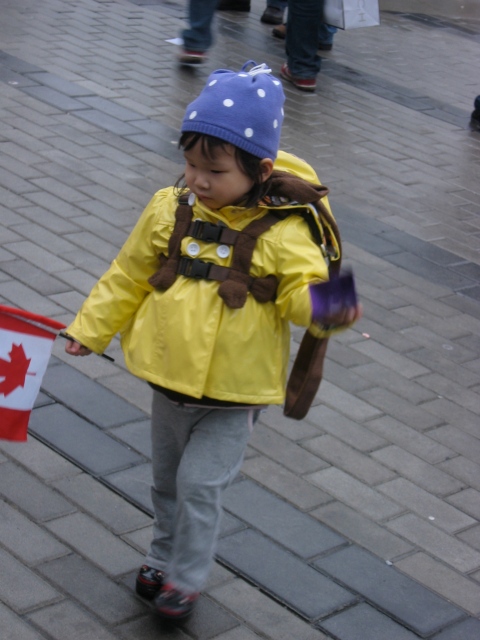
You must be logged in to post a comment.